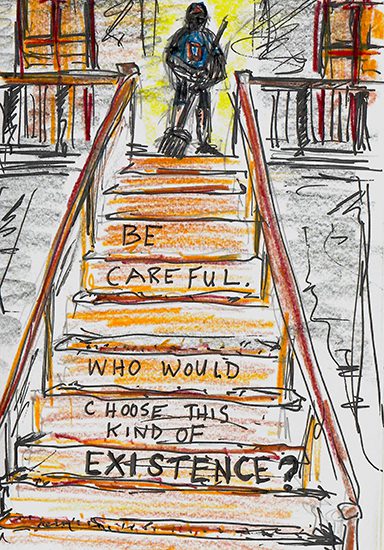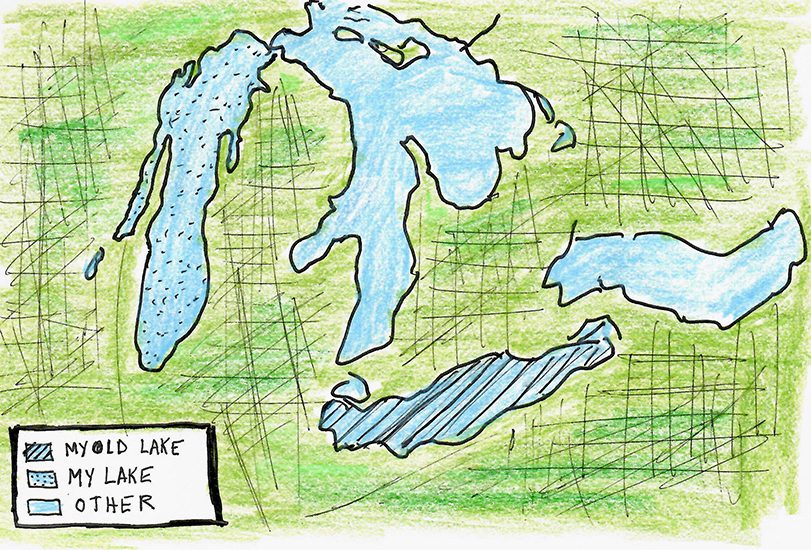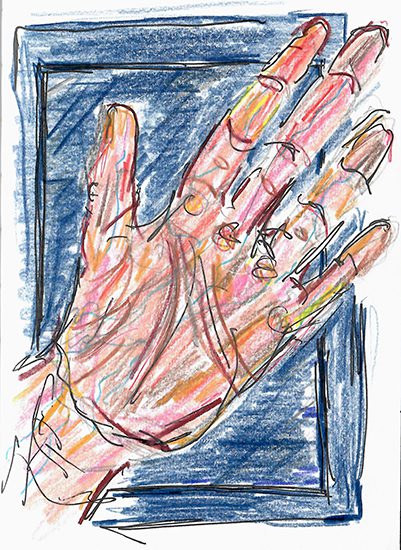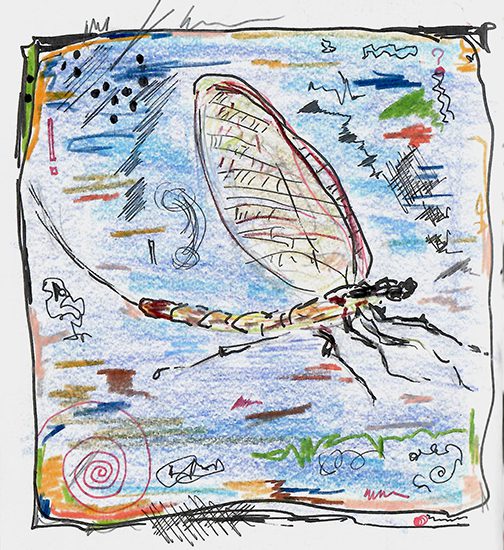Mayflies look like worms with wings. Billions of them rise from the bottom of Lake Erie in the early summer and swarm around southeastern Michigan. Their adult lifespans are between twenty-four and seventy-two hours, so they mate until the sun comes up; then they die, and their bodies turn into crispy chips.
My father lived in a second-floor apartment adjacent to Lake Erie. Leading up to his door was a steep wooden staircase, and during the three-day mayfly hatch in the summer, he would have to sweep off thousands of carcasses from the landing. To not do so would result in a rather treacherous climb, for it’s very easy to slip on a carpet of dead mayflies.
While living at my mother’s house during my college summer break, I went to visit him. I found my father at the top of his tall staircase, broom in hand, a cloud of wings drifting down to the ground.
“Be careful,” he warned.
I gripped the handrail and slowly climbed as corpses crunched underfoot. “Ew, gross,” I whined. My father stifled a laugh.
I hated driving to his place; it was a reminder that he had abandoned his family, abandoned me. But I especially hated it this time of year.

Even though mayflies are bad news for locals, their presence is actually good news for the lake. Mayfly larvae only exist in water that is very clean. And for seventy years, Lake Erie had been anything but clean. Industrial pollution from big corporations, oil spills from commercial tankers, overloaded sewers spewing untreated wastewater, and phosphates from runoff fertilizers and insecticides robbed the lake of its natural ecosystems.
People turned a blind eye for longer than they should have. If there was pollution from industry and agriculture, then that meant those businesses were booming, people had jobs, and the economy was stable. It was easier to make excuses than to clean up the mess.
In 1969, the Cuyahoga River, which feeds into Lake Erie, caught fire for the fourteenth time, old hat for Cleveland residents, only this time, national news covered the story, and Americans realized that when what you use to put out fire is on fire, it might be time to act.
Finally, the Environmental Protection Agency was created and (some) regulations came to companies that dotted the shore.
Cleanup didn’t happen overnight, however. Twenty years later, Lake Erie was still more of a joke than a destination. Its pungent smells made it undesirable for summer sunbathing. Dead, rotting fish washed up on the beach and scared away the tourists.

When I got my senior pictures taken at the shoreline in 2001, and I had to climb onto a nearby rock, I was careful not to let any of my skin dip into the water. We joked that to do so would result in sprouting an extra finger or a third eye. That’s how toxic we perceived the lake to be, a stigma that kept us from seeing the healing that was happening.
Because, by 2001, the lake was as healthy as it had been in a century. Thanks to federally mandated limits on how much phosphorus could be dumped into the lake, algae no longer overwhelmed the ecosystem. Scant amounts of mayfly larvae had been spotted on the lake bottom in 1991, and each year since, the population grew. The cleaner the water, the more larvae there, and judging by the dead swarm on my father’s deck, the lake was very healthy.
It took decades to clean up the lake. But finally, the efforts paid off.
My household, too, had been poisoned in the form of my father’s addiction to alcohol, his volatile attitude toward everything and everyone, especially his family. I spent most of my childhood hiding in my room, trying to ignore the shouting, the trinkets thrown at the wall, the doors slamming. I strove to be a good girl; I tried to be helpful or tried to stay out of the way. I hated the arguments and never wanted to be the one who caused them.
My mother always told me she stayed with him longer than she should have to keep the family together. But we were Catholic, and divorce was a sin, and he made most of the household income at his factory job.
It was easier to make excuses than to clean up the mess.
Eventually, he spent a night in jail for drunk driving, and my mother decided that was enough. In 1997, just before I entered eighth grade, my parents divorced. My father moved out, I emerged from my hiding, and my mother thought everything was fixed.
But after twenty-five years of being belittled by my father, my mother felt like she was the failure, that she should have done more to help him, to save him. And her outspoken anxiety sparked my own. I heard stories of their early marriage where they seemed to be happy and in love. Did the problems start when I came around? Had I been too much trouble? Did I drive him away? Did he love beer more than he loved me? Was I worthy of love?
I never asked him those questions. I was too scared of the answers.
Instead, I let my fear fester. I was angry at him for breaking our family. I hated him for the miserable and harmful thoughts that his actions had caused me to face.
One night, he was staying in his old house with me while my mom was away on business. I was seething that my mom had asked him to care for me. I was a teenager, moody and uptight; I hadn’t needed anyone to take care of me, and besides, he never took care of me when he lived there, so why should my mom have expected him to be able to do it now? I was delusional and ungrateful.
He stood at the stove making me mac and cheese for dinner. I was pacing in the adjacent family room, unsure what to do with these feelings. I don’t know what he said, if anything, to provoke me. It’s possible the words burst out with no preface whatsoever.
“I hate you!” I shouted, fists balling, arms slamming into my sides.
He was the man whose words hurt everyone else, but now I was the one spitting pain. Me, his good girl, his people-pleaser, his quiet one. Sure, I was a teenager, and teenagers always told their parents they hated them. But this wasn’t that.
My father went back to stirring the noodles. Yet nothing was the same.
He would stop calling me, stop asking me to visit. He would always claim he didn’t want to interrupt my busy life. And I would move across the state to go to college and forget to call.
He may have made the initial fracture in our relationship, but my words were the ones that sliced all the way through.
Mayflies can live underwater for years. In their nymph form, they rest on the bottom of the lake, sucking in algae. They cleverly divert the water around them, confusing predators. They lead quiet and safe lives.
The adults have no defense mechanism; even if they had one, they wouldn’t have time to use it with their short lifespans. Thus, fish and birds alike feast on the mayflies as they swarm, like a buffet. Mayflies have mouths that can’t eat and stomachs filled with air, so I doubt they have any kind of brain to reason, and good thing, too, because why would a nymph ever leave the comfort and safety of the water to knowingly die?
At least they all mature together, all rise together, all die together.
No one gets left behind.
I was left behind.
My mother had to get a part-time job in addition to her full-time one to pay the mortgage and the bills. I often came home to an empty house.
It’s not that I missed those earlier years of angry cacophony, exactly, but sometimes the silence was worse.
Mayflies, like humans, have three distinct life stages: child, adolescent, adult. They gain wings in their adolescent phase, but, like humans, it’s an awkward stage. They are poor fliers and sexually immature. Lucky for them, this stage is the shortest. For some mayflies, adolescence lasts only minutes before they molt one more time into their adult selves.
Human adolescence might be short in comparison to adulthood, but it feels long.
Halfway through mine, I graduated high school, then sprouted my first set of wings and fled to the other side of the state for college.
Lake Michigan became my lake. A wonderful lake at that—revered for its sandy shores, its clear waters, a vastness so great, it feels like an ocean.
It is too deep for mayflies.
My friends and I had no qualms about swimming in that lake, even in April, as we celebrated the end of another college year together.
We knew the water was just above freezing then, but we jumped in at full force, not daring to test the temperature ahead of time. No, instead, we rushed in, the ice-cold water hitting our ankles, our calves, our knees, as we screamed in delight and panic but pressed on. The waves were up to our waist when we lunged forward and plunged underneath, soaking our faces, heads, and hair. We surfaced, gasping—our lungs arresting from the chill. Some of us turned around and raced back to shore; some of us proved our fortitude by dunking back in again. It takes mere minutes for hypothermia to set in, and we knew it was dangerous, but that was part of the fun. Once we were all on dry sand, we heaved with heavy chests and bellowed out laughter. We wrapped ourselves in our towels and collapsed in exhaustion onto the beach.
In order to feel alive, we put our lives in peril.
Without mayflies, there were no telltale signs that Lake Michigan was either healthy or sick. Whatever ailments Lake Michigan suffered stayed a secret.
But there was sickness, much like what Lake Erie suffered, near the bigger industrial cities that dotted its shores. There were phosphates from chemicals and agricultural runoff, but algae hid in the depths. Throughout its massiveness, microplastics—plastics that have broken down over time—drifted undetected in the waves, leeching their chemicals into the water, poisoning the animals that ingested them, perhaps slowly poisoning us as we filled our glasses from the tap.
I tried not to think about that. I floated and splashed in the clear cold waters, laid on the clean beaches, and allowed the sun to warm me back up again. I drank the water without concern. I boasted my privilege to live near such a pristine lake.
But there was damage underneath.
There were unspoken restrictions put in place as my father and I set to heal our broken relationship. We allowed each other to talk about superficial events in our lives—my schoolwork, our jobs, his health, the health of all my aunts and uncles. Detroit sports was a safe topic. What the weather was like took up the majority of our phone calls.
Emotions, the past, any hurt either of us may or may not have suffered were prohibited subjects.
Dad and I reached a comfortable plateau. To an outsider, we appeared to have a normal, healthy relationship.
But there was damage underneath.

As my feet slipped on the steps, vacant bug eyes staring up at me, so many wormlike bodies that I couldn’t even see the wood underneath, I felt pity. Who would choose this kind of existence?
Mayflies live their short lives for the next generation. Mayflies sacrifice themselves for their children.
When my father left, I worried that I had driven away. But it’s possible he thought I’d be better off without him. I may have confirmed those fears when I told him I hated him. Maybe he thought my life would be happier if he wasn’t in it.
Maybe he sacrificed himself for me.
Our relationship wasn’t pristine; the pain we inflicted on each other floated undetected among the love we showed one another. There would always be a little bit of poison between us. But we were trying to clean up the mess.
As I neared the top of the staircase, he reached out his hand to help me the rest of the way. His calloused skin snagged on my smooth palm, but he held tight.
***
Rumpus original art by Peter Witte.
Voices on Addiction is a column devoted to true personal narratives of addiction, curated by Kelly Thompson, and authored by the spectrum of individuals affected by this illness. Through these essays, interviews, and book reviews we hope—in the words of Rebecca Solnit—to break the story by breaking the status quo of addiction: the shame, stigma, and hopelessness, and the lies and myths that surround it. Sisters, brothers, mothers, fathers, adult children, extended family members, spouses, friends, employers or employees, boyfriends, girlfriends, neighbors, victims of crimes, and those who’ve committed crimes as addicts, and the personnel who often serve them, nurses, doctors, social workers, therapists, prison guards, police officers, policy makers and, of course, addicts themselves: Voices on Addiction will feature your stories. Because the story of addiction impacts us all. It’s time we break it. Submit here.




